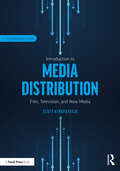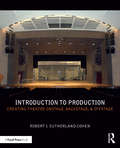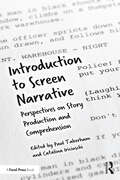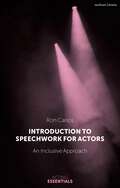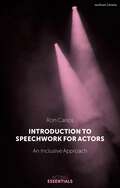- Table View
- List View
Introduction to Media Distribution: Film, Television, and New Media
by Scott KirkpatrickIntroduction to Media Distribution offers a clear, direct and comprehensive overview of the entire film, television and new media distribution business, valuable to both students and professionals. In this book, author Scott Kirkpatrick draws from over a decade of personal experience in the distribution arena to explore what fuels the distribution process, and explains in real-world terms how the business works from beginning to end—not merely what happens to a film or television series after a distributor acquires it, but how distributors develop, pre-sell and broker deals on content before it even exists. Kirkpatrick covers deal structures, release strategies, acquisition approaches, rights sales, international co-productions, tax credits, audience research, global regulatory boards, and even ‘behind closed doors’ monetization practices. The book offers: A straightforward, clear and insightful approach to understanding the fundamental basics of how the global distribution marketplace works, and how distribution companies actually operate and create the content they need; An insider’s analysis of all levels of the business with an emphasis on the independent scene, the root from where development in the industry grows; A comprehensive overview of how film and television markets and festivals work, and how buyers and sellers actually broker deals in the field; Detailed explanations of how each media right is defined and windowed to maximize potential revenue; A detailed overview of several major international territories, and how each operates within the context of the global media business; Guidance and advice from an industry expert on how one can initiate their professional career in the entertainment industry, applicable to individuals in all roles; A robust appendix containing in-depth studies of legal definitions, material delivery requirements, territory-by-territory financial projections, and more. An accompanying eResource offers template contracts, sample agreements, and further resources for download.
Introduction to Media Distribution: Film, Television, and New Media
by Scott KirkpatrickIntroduction to Media Distribution offers a clear, direct and comprehensive overview of the entire film, television and new media distribution business, valuable to both students and professionals. In this book, author Scott Kirkpatrick draws from over a decade of personal experience in the distribution arena to explore what fuels the distribution process, and explains in real-world terms how the business works from beginning to end—not merely what happens to a film or television series after a distributor acquires it, but how distributors develop, pre-sell and broker deals on content before it even exists. Kirkpatrick covers deal structures, release strategies, acquisition approaches, rights sales, international co-productions, tax credits, audience research, global regulatory boards, and even ‘behind closed doors’ monetization practices. The book offers: A straightforward, clear and insightful approach to understanding the fundamental basics of how the global distribution marketplace works, and how distribution companies actually operate and create the content they need; An insider’s analysis of all levels of the business with an emphasis on the independent scene, the root from where development in the industry grows; A comprehensive overview of how film and television markets and festivals work, and how buyers and sellers actually broker deals in the field; Detailed explanations of how each media right is defined and windowed to maximize potential revenue; A detailed overview of several major international territories, and how each operates within the context of the global media business; Guidance and advice from an industry expert on how one can initiate their professional career in the entertainment industry, applicable to individuals in all roles; A robust appendix containing in-depth studies of legal definitions, material delivery requirements, territory-by-territory financial projections, and more. An accompanying eResource offers template contracts, sample agreements, and further resources for download.
Introduction to Media Distribution: Film, Television, and New Media
by Scott KirkpatrickIn this second edition, author Scott Kirkpatrick draws from over a decade of personal experience in the distribution arena to provide a clear and up-to-date overview of the entire film, television, and new media distribution business. Readers will learn what fuels the distribution process and exactly how the distribution business works from beginning to end—not merely what happens to a film or television series upon acquisition, but how distributors develop, presell and broker deals on content before it even exists. This new edition considers a much more international approach to media distribution, with case studies and analyses from across the globe. It also reflects on the ever-increasing relevance of diversity and inclusiveness in the industry, as well as the new media verticals like podcasts and the effects of social media influencers on the media landscape. The book will be an integral guidebook for any student or professional wishing to understand both the basics and the subtleties of media distribution. The book also contains a robust appendix containing in-depth studies of legal definitions, material delivery requirements, territory-by-territory financial projections and more.
Introduction to Media Distribution: Film, Television, and New Media
by Scott KirkpatrickIn this second edition, author Scott Kirkpatrick draws from over a decade of personal experience in the distribution arena to provide a clear and up-to-date overview of the entire film, television, and new media distribution business. Readers will learn what fuels the distribution process and exactly how the distribution business works from beginning to end—not merely what happens to a film or television series upon acquisition, but how distributors develop, presell and broker deals on content before it even exists. This new edition considers a much more international approach to media distribution, with case studies and analyses from across the globe. It also reflects on the ever-increasing relevance of diversity and inclusiveness in the industry, as well as the new media verticals like podcasts and the effects of social media influencers on the media landscape. The book will be an integral guidebook for any student or professional wishing to understand both the basics and the subtleties of media distribution. The book also contains a robust appendix containing in-depth studies of legal definitions, material delivery requirements, territory-by-territory financial projections and more.
Introduction to Media Production: The Path to Digital Media Production
by Gorham Kindem Robert B. MusburgerIntroduction to Media Production began years ago as an alternative text that would cover ALL aspects of media production, not just film or just tv or just radio. Kindem and Musburger needed a book that would show students how every form of media intersects with one another, and about how one needs to know the background history of how film affects video, and how video affects working in a studio, and ultimately, how one needs to know how to put it all together. Introduction to Media Production is the book that shows this intersection among the many forms of media, and how students can use this intersection to begin to develop their own high quality work.Introduction to Media Production is a primary source for students of media. Its readers learn about various forms of media, how to make the best use of them, why one would choose one form of media over another, and finally, about all of the techniques used to create a media project. The digital revolution has exploded all the former techniques used in digital media production, and this book covers the now restructured and formalized digital workflows that make all production processes by necessity, digital. This text will concentrate on offering students and newcomers to the field the means to become aware of the critical importance of understanding the end destination of their production as a part of pre-production, not the last portion of post production.Covering film, tv, video, audio, and graphics, the fourth edition of Introduction to Digital Media promises to be yet another comprehensive guide for both students of media and newcomers to the media industry.
Introduction to Media Production: The Path to Digital Media Production
by Gorham Kindem Robert B. MusburgerIntroduction to Media Production began years ago as an alternative text that would cover ALL aspects of media production, not just film or just tv or just radio. Kindem and Musburger needed a book that would show students how every form of media intersects with one another, and about how one needs to know the background history of how film affects video, and how video affects working in a studio, and ultimately, how one needs to know how to put it all together. Introduction to Media Production is the book that shows this intersection among the many forms of media, and how students can use this intersection to begin to develop their own high quality work.Introduction to Media Production is a primary source for students of media. Its readers learn about various forms of media, how to make the best use of them, why one would choose one form of media over another, and finally, about all of the techniques used to create a media project. The digital revolution has exploded all the former techniques used in digital media production, and this book covers the now restructured and formalized digital workflows that make all production processes by necessity, digital. This text will concentrate on offering students and newcomers to the field the means to become aware of the critical importance of understanding the end destination of their production as a part of pre-production, not the last portion of post production.Covering film, tv, video, audio, and graphics, the fourth edition of Introduction to Digital Media promises to be yet another comprehensive guide for both students of media and newcomers to the media industry.
Introduction to Media Production: The Path to Digital Media Production
by Robert B. Musburger Gorham KindemIntroduction to Media Production, Third Edition, provides students with a practical framework for all aspects of media production by addressing the technological and aesthetic changes that have shaped the industry. Offering both hands-on instruction and theoretical information, it provides a sound basis for the techniques, operations, and philosophies of media production in the new digital environment.The new edition has been updated throughout with detailed information on how digital processes have changed everything from shooting to editing to finishing. It includes content on the Internet, writing for the Internet, Graphics and Animation.
Introduction to Media Production: The Path to Digital Media Production
by Robert B. Musburger Gorham KindemIntroduction to Media Production, Third Edition, provides students with a practical framework for all aspects of media production by addressing the technological and aesthetic changes that have shaped the industry. Offering both hands-on instruction and theoretical information, it provides a sound basis for the techniques, operations, and philosophies of media production in the new digital environment.The new edition has been updated throughout with detailed information on how digital processes have changed everything from shooting to editing to finishing. It includes content on the Internet, writing for the Internet, Graphics and Animation.
Introduction to Production: Creating Theatre Onstage, Backstage, & Offstage
by Robert I. Sutherland-CohenIntroduction to Production: Creating Theatre Onstage, Backstage, & Offstage defines the collaborative art of making theatre and the various job positions that go into realizing a production. Beginning with an overview of the art and industry of theatre, the book shows how theatre has evolved through history. The book then breaks down the nuts and bolts of the industry by looking at each professional role within it: from the topmost position of the producer down to the gopher, or production assistant. Each of these positions are defined along with their respective duties, rules, and resources that figure in obtaining these jobs. Each chapter offers exercises, links to videos and websites, review quizzes, and suggested readings to learn more about the creation and production of theatre.
Introduction to Production: Creating Theatre Onstage, Backstage, & Offstage
by Robert I. Sutherland-CohenIntroduction to Production: Creating Theatre Onstage, Backstage, & Offstage defines the collaborative art of making theatre and the various job positions that go into realizing a production. Beginning with an overview of the art and industry of theatre, the book shows how theatre has evolved through history. The book then breaks down the nuts and bolts of the industry by looking at each professional role within it: from the topmost position of the producer down to the gopher, or production assistant. Each of these positions are defined along with their respective duties, rules, and resources that figure in obtaining these jobs. Each chapter offers exercises, links to videos and websites, review quizzes, and suggested readings to learn more about the creation and production of theatre.
Introduction to Puppetry Arts
by Cheralyn LambethIntroduction to Puppetry Arts shares the history, cultures, and traditions surrounding the ancient performance art of puppetry, along with an overview of puppet construction and performance techniques used around the world. From its earliest beginnings in the ancient Middle East and Asia, through its representations in Medieval/Renaissance Europe, up until its modern-day appearances in theatre, television, and film, this book offers a thorough overview of how this fascinating art form originated and evolved. It also includes easy-to-follow instructions on how to create puppets for performance and display and an in-depth resource list and bibliography for further research and information. Written for students in puppetry arts and stagecraft courses, Introduction to Puppetry Arts offers a comprehensive look at this enduring craft and provides a starting point for creating a wide range of puppets, from marionettes and hand puppets to mascots and character costumes.
Introduction to Puppetry Arts
by Cheralyn LambethIntroduction to Puppetry Arts shares the history, cultures, and traditions surrounding the ancient performance art of puppetry, along with an overview of puppet construction and performance techniques used around the world. From its earliest beginnings in the ancient Middle East and Asia, through its representations in Medieval/Renaissance Europe, up until its modern-day appearances in theatre, television, and film, this book offers a thorough overview of how this fascinating art form originated and evolved. It also includes easy-to-follow instructions on how to create puppets for performance and display and an in-depth resource list and bibliography for further research and information. Written for students in puppetry arts and stagecraft courses, Introduction to Puppetry Arts offers a comprehensive look at this enduring craft and provides a starting point for creating a wide range of puppets, from marionettes and hand puppets to mascots and character costumes.
Introduction to Screen Narrative: Perspectives on Story Production and Comprehension
by Paul Taberham Catalina IricinschiBringing together the expertise of world-leading screenwriters and scholars, this book offers a comprehensive overview of how screen narratives work. Exploring a variety of mediums including feature films, television, animation, and video games, the volume provides a contextual overview of the form and applies this to the practice of screenwriting. Featuring over 20 contributions, the volume surveys the art of screen narrative, and allows students and screenwriters to draw on crucial insights to further improve their screenwriting craft. Editors Paul Taberham and Catalina Iricinschi have curated a volume that spans a range of disciplines including screenwriting, film theory, philosophy and psychology with experience and expertise in storytelling, modern blockbusters, puzzle films and art cinema. Screenwriters interviewed include: Josh Weinstein (The Simpsons, Gravity Falls), David Greenberg (Stomping Ground, Used to Love Her), Evan Skolnick and Ioana Uricaru. Ideal for students of Screenwriting and Screen Narrative as well as aspiring screenwriters wanting to provide theoretical context to their craft.
Introduction to Screen Narrative: Perspectives on Story Production and Comprehension
Bringing together the expertise of world-leading screenwriters and scholars, this book offers a comprehensive overview of how screen narratives work. Exploring a variety of mediums including feature films, television, animation, and video games, the volume provides a contextual overview of the form and applies this to the practice of screenwriting. Featuring over 20 contributions, the volume surveys the art of screen narrative, and allows students and screenwriters to draw on crucial insights to further improve their screenwriting craft. Editors Paul Taberham and Catalina Iricinschi have curated a volume that spans a range of disciplines including screenwriting, film theory, philosophy and psychology with experience and expertise in storytelling, modern blockbusters, puzzle films and art cinema. Screenwriters interviewed include: Josh Weinstein (The Simpsons, Gravity Falls), David Greenberg (Stomping Ground, Used to Love Her), Evan Skolnick and Ioana Uricaru. Ideal for students of Screenwriting and Screen Narrative as well as aspiring screenwriters wanting to provide theoretical context to their craft.
Introduction to SNG and ENG Microwave
by Jonathan HigginsAn excellent primer on the subject, this book gives beginning professionals in satellite newsgathering an introduction to the technologies and processes involved. It will also suit journalists, editors and producers needing to understand this important element of the newsgathering chain. Written for the complete beginner, the book shows how typical transmission chains work and their communication with the studio. It also offers a brief introduction to analogue and digital theory before going onto to explain Electronic Newsgathering (ENG) systems: from basic principles: transmission and reception chains, frequencies used and why, through to audio channel, subcarriers and digital modulation, as well as applications: radio cameras, window links, infra-red & laser links.A brief chapter on satellite theory gives an overview of satellite communication and orbits, basic satellite communication theory, transportables (`flyaways') and trucks, as well as analogue vs digital issues, digital compression and MPEG. Systems regulations and operations are also introduced as well as safety and logistics issues.If you're looking for a quick and easy introduction to the subject, this book will act as an essential on the job reference guide.
Introduction to SNG and ENG Microwave
by Jonathan HigginsAn excellent primer on the subject, this book gives beginning professionals in satellite newsgathering an introduction to the technologies and processes involved. It will also suit journalists, editors and producers needing to understand this important element of the newsgathering chain. Written for the complete beginner, the book shows how typical transmission chains work and their communication with the studio. It also offers a brief introduction to analogue and digital theory before going onto to explain Electronic Newsgathering (ENG) systems: from basic principles: transmission and reception chains, frequencies used and why, through to audio channel, subcarriers and digital modulation, as well as applications: radio cameras, window links, infra-red & laser links.A brief chapter on satellite theory gives an overview of satellite communication and orbits, basic satellite communication theory, transportables (`flyaways') and trucks, as well as analogue vs digital issues, digital compression and MPEG. Systems regulations and operations are also introduced as well as safety and logistics issues.If you're looking for a quick and easy introduction to the subject, this book will act as an essential on the job reference guide.
Introduction to Speechwork for Actors: An Inclusive Approach (Acting Essentials)
by Ron CarlosTraditional speech work has long favored an upper-class white accent as the model of intelligibility. Because of that, generations of actors have felt disconnected from their own identities and acting choices.This much-needed textbook redresses that trend and encourages actors to achieve intelligibility through rigorous language analysis and an exploration of their own accent and articulation practices.Following an acting class model, where you first analyze the script then reveal yourself through it, this work breaks down a process for analyzing language in a way that excites the imagination. Guiding the student through the labyrinth of abstract concepts and terms, readers are delivered into the practicality of exercises and explorations, giving them self-awareness that enables them to make their own speech come alive.Informed throughout by notes from the author's own extensive experience working with directors and acting teachers, this book serves as an ideal speech-training resource for the 21st -century actor, and includes specially commissioned online videos demonstrating key exercises.
Introduction to Speechwork for Actors: An Inclusive Approach (Acting Essentials)
by Ron CarlosTraditional speech work has long favored an upper-class white accent as the model of intelligibility. Because of that, generations of actors have felt disconnected from their own identities and acting choices.This much-needed textbook redresses that trend and encourages actors to achieve intelligibility through rigorous language analysis and an exploration of their own accent and articulation practices.Following an acting class model, where you first analyze the script then reveal yourself through it, this work breaks down a process for analyzing language in a way that excites the imagination. Guiding the student through the labyrinth of abstract concepts and terms, readers are delivered into the practicality of exercises and explorations, giving them self-awareness that enables them to make their own speech come alive.Informed throughout by notes from the author's own extensive experience working with directors and acting teachers, this book serves as an ideal speech-training resource for the 21st -century actor, and includes specially commissioned online videos demonstrating key exercises.
An Introduction to Storytelling
by The Society for StorytellingWhere do stories come from, and how do we come to know them? Daughters listen with wonder to their grandmothers’ tales. Journalists have their trusted sources. Writers of storybooks draw unconsciously from the works of their predecessors. It is as if every story has within it an infallible truth, contained in the echo of its original telling. The storyteller recounts the tale. The listener hears, learns and remembers. In due course they will retell the same tale, adding in something of their own. And so listeners in time turn into storytellers. This inspiring book brings together the stories from across the world of listeners who themselves became storytellers. They reveal who influenced them the most, what drew them further in, what they learnt, and what they now wish to share with new generations. Tips, tools and tales: read this book, and take your turn.
Introduction to the Alexander Technique: A Practical Guide for Actors (Acting Essentials)
by Bill ConningtonIntroduction to the Alexander Technique, part of the brand-new Acting Essentials series, is the first textbook about the Alexander Technique written specially for undergraduates. This eight-week program can be taught over the course of half a semester, a full semester, or dipped into as needed to address students' issues with physicality, movement, breathing, voice and performance habits. The Alexander Technique has been a vital part of training for performers since the early 20th century. It is a core part of the curriculum at most acting conservatories and in many BFA programs. Sometimes considered purely a movement discipline, the Alexander Technique in fact takes into consideration the entire person-mind, body, voice, emotions, and imagination. Introduction to the Alexander Technique addresses the student's self as a whole and is suitable for beginning acting students in any academic setting, including those who take performance classes as an elective. The book also includes more than 150 practical, easy-to-follow exercises that help students reduce tension and improve their alignment, flexibility, and poise. The textbook is supported by a range of online videos demonstrating key exercises described throughout the book.
Introduction to the Alexander Technique: A Practical Guide for Actors (Acting Essentials)
by Bill ConningtonIntroduction to the Alexander Technique, part of the brand-new Acting Essentials series, is the first textbook about the Alexander Technique written specially for undergraduates. This eight-week program can be taught over the course of half a semester, a full semester, or dipped into as needed to address students' issues with physicality, movement, breathing, voice and performance habits. The Alexander Technique has been a vital part of training for performers since the early 20th century. It is a core part of the curriculum at most acting conservatories and in many BFA programs. Sometimes considered purely a movement discipline, the Alexander Technique in fact takes into consideration the entire person-mind, body, voice, emotions, and imagination. Introduction to the Alexander Technique addresses the student's self as a whole and is suitable for beginning acting students in any academic setting, including those who take performance classes as an elective. The book also includes more than 150 practical, easy-to-follow exercises that help students reduce tension and improve their alignment, flexibility, and poise. The textbook is supported by a range of online videos demonstrating key exercises described throughout the book.
An Introduction to Theatre, Performance and the Cognitive Sciences (Performance and Science: Interdisciplinary Dialogues)
by John LutterbieThis is the first textbook designed for students, practitioners and scholars of the performing arts who are curious about the power of the cognitive sciences to throw light on the processes of performance. It equips readers with a clear understanding of how research in cognitive neuroscience has illuminated and expanded traditional approaches to thinking about topics such as the performer, the spectator, space and time, culture, and the text. Each chapter considers four layers of performance: conventional forms of theatre, performance art, and everyday life, offering an expansive vision of the impact of the cognitive sciences on performance in the widest sense. Written in an approachable style, An Introduction to Theatre, Performance and the Cognitive Sciences weaves together case studies of a wide range of performances with scientific evidence and post-structural theory. Artists such as Robert Wilson, Societas Raffaello Sanzio, Ariane Mnouchkine, Bertolt Brecht, and Antonin Artaud are brought into conversation with theories of Gilles Deleuze, Shaun Gallagher, Alva Noë, Tim Ingold and the science of V. S. Ramachandran, Vittorio Gallese, and Antonio Damasio. John Lutterbie offers a complex understanding of not only the act of performing but the forces that mark the place of theatre in contemporary society.In drawing on a variety of scientific articles, Lutterbie provides readers with an accessible account of significant research in areas in the field and reveals how the sciences can help us understand the experience of art.
An Introduction to Theatre, Performance and the Cognitive Sciences (Performance and Science: Interdisciplinary Dialogues)
by John LutterbieThis is the first textbook designed for students, practitioners and scholars of the performing arts who are curious about the power of the cognitive sciences to throw light on the processes of performance. It equips readers with a clear understanding of how research in cognitive neuroscience has illuminated and expanded traditional approaches to thinking about topics such as the performer, the spectator, space and time, culture, and the text. Each chapter considers four layers of performance: conventional forms of theatre, performance art, and everyday life, offering an expansive vision of the impact of the cognitive sciences on performance in the widest sense. Written in an approachable style, An Introduction to Theatre, Performance and the Cognitive Sciences weaves together case studies of a wide range of performances with scientific evidence and post-structural theory. Artists such as Robert Wilson, Societas Raffaello Sanzio, Ariane Mnouchkine, Bertolt Brecht, and Antonin Artaud are brought into conversation with theories of Gilles Deleuze, Shaun Gallagher, Alva Noë, Tim Ingold and the science of V. S. Ramachandran, Vittorio Gallese, and Antonio Damasio. John Lutterbie offers a complex understanding of not only the act of performing but the forces that mark the place of theatre in contemporary society.In drawing on a variety of scientific articles, Lutterbie provides readers with an accessible account of significant research in areas in the field and reveals how the sciences can help us understand the experience of art.
Introduction to Video Production: Studio, Field, and Beyond
by Ronald Compesi Jaime GomezWritten in a clear, non-technical manner, Introduction to Video Production focuses on the fundamental principles of video production and the technologies used in production. This book discusses video aesthetics, technologies, and production practice in a clear and concise manner. It also emphasizes the importance of teamwork and planning in the production process. Chapters are clearly organized and heavily illustrated, with key terms identified in boldface. With Introduction to Video Production, readers will learn not only how the technology works, but how to work with the technology and with each other.
Introduction to Video Production: Studio, Field, and Beyond
by Ronald Compesi Jaime GomezWritten in a clear, non-technical manner, Introduction to Video Production focuses on the fundamental principles of video production and the technologies used in production. This book discusses video aesthetics, technologies, and production practice in a clear and concise manner. It also emphasizes the importance of teamwork and planning in the production process. Chapters are clearly organized and heavily illustrated, with key terms identified in boldface. With Introduction to Video Production, readers will learn not only how the technology works, but how to work with the technology and with each other.

